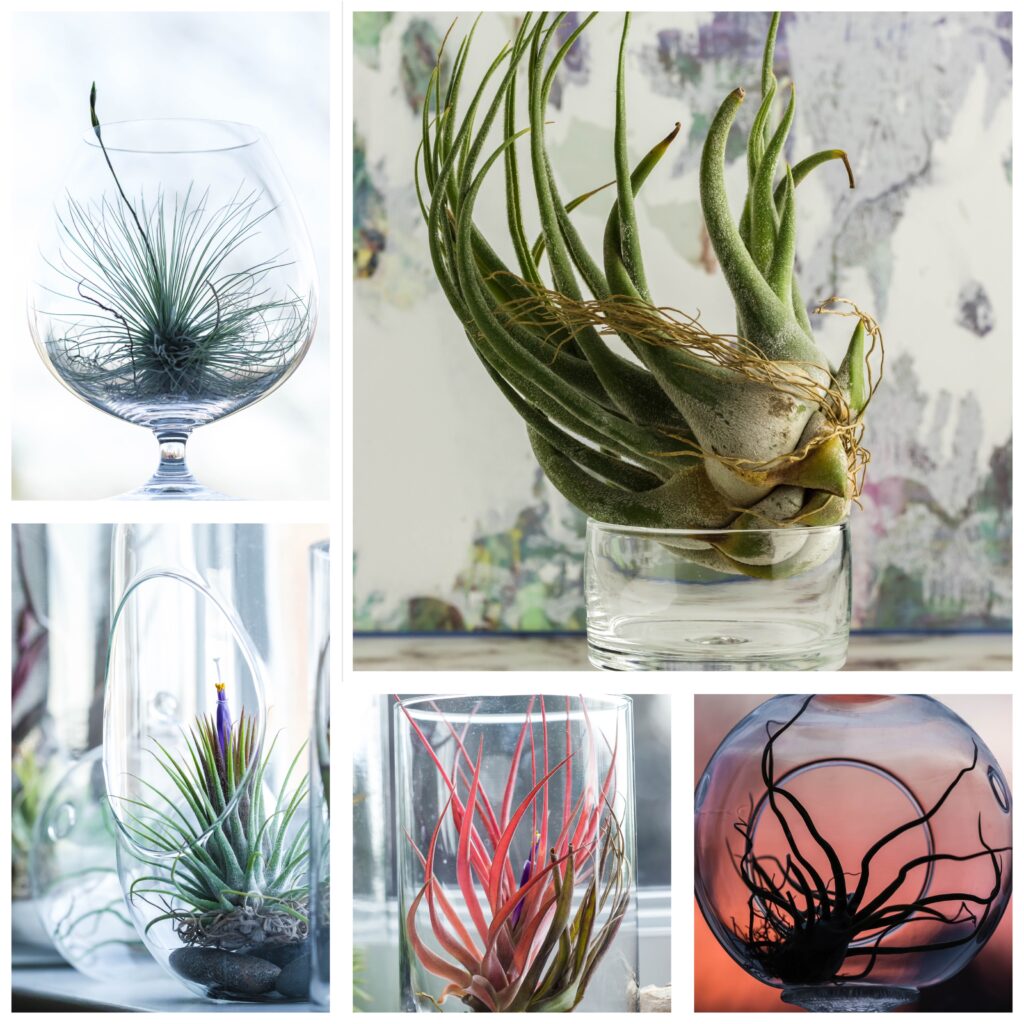By Sue Healey, Tillsonburg Horticultural Society
I’ve written before about window gardens. About their importance in getting me through the winter months of Southwestern Ontario. Last year I introduced you to my Orchid window and they are once again stretching their way to the light, buds still clasped tight. This year I wanted to introduce you to another of my window gardens. This one, strange and wonderful and filled with plants unlike most. Here on a narrow ledge in the milky Northeastern light, grow my collection of Tillandsia, sometimes known as air-plants. Reclining in their glass houses, seemingly sipping on nothing more than air, these alien beautiesbring interest and colour to indoor spaces with their varied forms and spectacular blooms. This epiphytic member of the Bromeliad family is easy to grow, long lived, and worthy of featured spot in any indoor plantscape.
The Tillandsia family is vast and varied with varieties that range from miniature puffs to bulbs as large as the hand. As always, the rabbit hole of collection beckons, so consider yourself warned. Native to the southern regions of the Americas, both arid and moist, these plants come in dozens of forms adapted to each. Most send out spectacular blooms, usually blue and often preceded by richly coloured leaf bracts or foliage in hues of pink and red. All done without the benefit of a traditional root system. Instead, they take nutrients from moisture in the airusing small appendages along their leaves called trichomes. Species from dryer areas (known as xeric types) are often covered in more than their rainforest cousins (mesic types) giving them a fuzzy appearance. In their native habitats, Tillandsia situate themselves in the crooks of trees where accumulating debris and moisture secure and feed them. Blooming is usually followed by the formation of offsets, called ‘pups’ and the gradual decline of the parent plant. Pups can be gently pried loose at half size or left attached until they toomature and bloom. The ability to grow without soil allows us to use the species at home in ways that traditional flora can’t be. Whether set in glass globes designed specifically for them, or strung on frames, wired to driftwood or tucked into the fork of an indoor tree, your imagination is the only limit to how these plants can be displayed.
My window is blessedly long, providing enough light and ledgefor just a few of the small to medium varieties available. The largest is T. circinnata, known as the pot-belled air-plant. 45cm tall and heavy in the hand, the bulbous base and arching leaves are covered in long trichomes, giving it a furry look. This species can be slow to bloom and divide. T. ionantha is the exact opposite, fitting into the palm of your hand and blushing to the tips of it’s crown before sending out up to three violet bloomsand sprouting multiple pups. Commonly found glued to driftwood or blown glass balls, they are an easy introduction to the family. T. baileyi, with it’s squid-like silhouette and rich purple skin, makes an impressive statement piece alone or as the star of a dry terrarium. T. balbosa, small and bulbous with crooked, cylindrical leaves adds a comical touch amongst the heavier species. My T. balbosas haven’t bloomed yet but I’ve read there is hope. I would have them regardless. There are others, isolated in their crystal homes – T. juncea, like a fan of long grass, T. fuchsia, needle fine leaves forming an almost perfect silver sphere, and T. brachycaulos, unassuming when not in flower, but a showstopper once it begins. August brings leaves striped in bubble-gum pink that quickly suffuses the whole plant to shocking pink before sending out a single, trumpet of violet blue and gold tipped stamens. Superb. These are but few examples of this broad and unique genus, each one offering an exciting challenge and a new perspective on what flora is.
In the wild, Tillandsia rely on humidity and rainfall to provide them with nutrients. At home, that role falls to us. If kept indoors, there are two methods of watering recommended:misting and soaking. Misting is most often advised for xeric types but must be done consistently and thoroughly to maintainhealthy plants. Soaking is easiest and my preference but only if plants aren’t mounted. An hour-long soak in shallow, tepid wateris a bi-weekly ritual in summer and a monthly one in winter. Drying them on the slant will ensure there’s no water hidden in their plated leaves to cause rot. I enjoy the watering of my Tillandsia as much as the flowering. Handling the plants gives me an intimate view of how they live. Their growth, ailments, even their decline, all part of the fascination, placing somewherebetween pet and plant. Given this treatment and an occasional spa day in the summer rain, they have bloomed and become many in their gratitude, just the thing to distract us from a bitter and bleak February morning.
Your local horticultural society has some great distractions planned for every season. Join us the first Tuesday of every month. February’s featured speaker is Robert Butt who will present “How to manage urban soils”. Members are also invited to attend the Seed Exchange happening at 6:30pm prior to the regular meeting.
Tuesday, February 4, 2025, Tillsonburg Seniors Centre, 7:30 pm
$20/year $5/meeting
“Come as guest, stay as a member”
📷 Sue H
